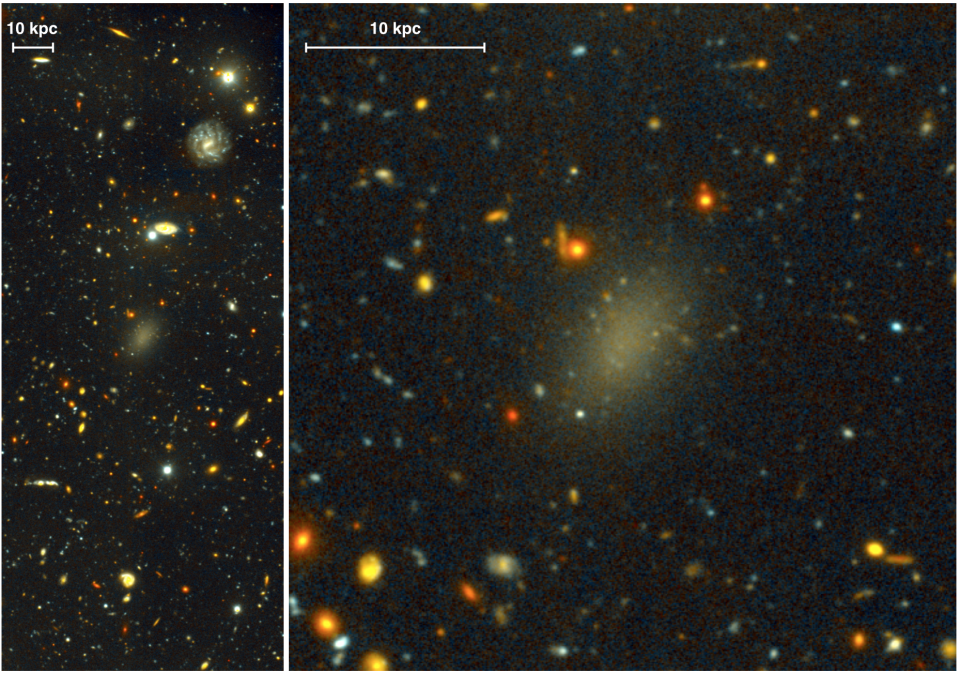Astronomers Discover New Galaxy That Is 99.99% Dark Matter

A team of astronomers at the Keck Observatory in Maunakea, Hawaii, have discovered a massive galaxy made of 99.99 percent dark matter.
The galaxy, called Dragonfly 44, is part of a collection of galaxies discovered a year ago by the same team. These galaxies are the same size and shape of regular galaxies, but contain far fewer stars. And now we know why: they're made almost entirely of dark matter.
Mysterious Origins
Dragonfly 44 is a strange sort of galaxy. It measures about 60,000 light years across, a little over half the width of our own galaxy, but it contains less than 1 percent of the stars. Its dim nature allowed it to elude astronomers until last year, when it was discovered by a team at the Keck Observatory.
The team identified a number of these galaxies in the Coma Cluster, a dense region of space containing over a thousand galaxies. They called them Ultra Diffuse Galaxies, or UDGs. Dragonfly 44 was the quintessential example: it was the largest and clearest of the UDGs found by the team.

Galaxies the size of Dragonfly 44 and the Milky Way usually have all the right ingredients for widespread star formation. These galaxies typically produce a very large numbers of stars-the Milky Way has some 100 billion-which makes Dragonfly 44's lack of stars even more mysterious.
"We have no idea how galaxies like Dragonfly 44 could have formed," says Roberto Abraham, a co-author of the study. "A relatively large fraction of the stars is in the form of very compact clusters, and that is probably an important clue. But at the moment we're just guessing."
Hunting for Dark Matter
UDGs like Dragonfly 44 couldn't possibly hold together with the mass of their stars alone. There are too few of them, and they are spread too thin. Especially in the dense Coma Cluster, the gravitational pull of other galaxies would tear them apart. So the Keck team decided to take a closer look at Dragonfly 44.
The astronomers spent six nights observing Dragonfly 44 using the Keck Telescope as well as the Gemini North telescope. They looked at not just the brightness of the stars, but how fast they were spinning. The faster the stars in the galaxy spin, the more mass the galaxy must have to keep them all from flying apart.

"Motions of the stars tell you how much matter there is," says lead author Pieter van Dokkum. "They don't care what form the matter is, they just tell you that it's there. Using the Keck Observatory, we found many times more mass indicated by the motions of the stars than there is mass in the stars themselves."
This is a common technique to calculate the amount of dark matter in a galaxy. The brightness of the stars can tell astronomers how much visible mass is in the galaxy, but the rotation tells them the total mass. The difference tells them how much dark matter there is.
The astronomers found that Dragonfly 44 is almost entirely dark matter. Visible matter only makes up only .01 percent of the total matter in the galaxy, and they're still not sure how it got that way.
Solving the Riddle
While scientists are at a loss to explain Dragonfly 44's surprising lack of stars, they are hopeful that the galaxy will be a helpful resource in studying dark matter. A large source like Dragonfly 44, with practically no stars to get in the way, could be an ideal spot to start looking.
"It helps to have objects that are almost entirely made of dark matter so we don't get confused by stars and all the other things that galaxies have," says van Dokkum. "The only such galaxies we had to study before were tiny. This finding opens up a whole new class of massive objects that we can study."
The Keck team is planning on looking at some of the other UDGs they've found to see if they have a similar amount of dark matter. They're also working on finding UDGs closer to home, which may be the key to uncovering what exactly dark matter even is.
"The race is on to find massive dark galaxies that are even closer to us than Dragonfly 44, so we can look for feeble signals that may reveal a dark matter particle."
You Might Also Like

